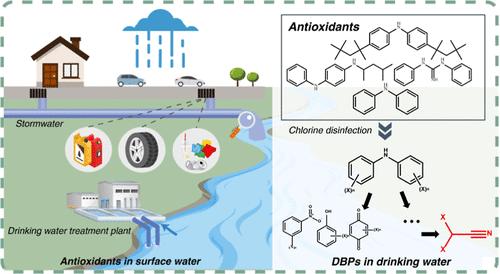当前位置:
X-MOL 学术
›
Environ. Sci. Technol.
›
论文详情
Our official English website, www.x-mol.net, welcomes your
feedback! (Note: you will need to create a separate account there.)
Widespread Antioxidants during Storm Events Could Serve as Precursors of Regulated, Priority, and New Disinfection Byproducts
Environmental Science & Technology ( IF 10.8 ) Pub Date : 2024-07-24 , DOI: 10.1021/acs.est.4c05815 Wenyuan Yang 1, 2, 3 , Chao Fang 1, 2, 3 , Yuntao Hong 1, 2, 3 , Zi-Feng Zhang 4 , Zuxin Xu 1, 2, 3 , Wenhai Chu 1, 2, 3
Environmental Science & Technology ( IF 10.8 ) Pub Date : 2024-07-24 , DOI: 10.1021/acs.est.4c05815 Wenyuan Yang 1, 2, 3 , Chao Fang 1, 2, 3 , Yuntao Hong 1, 2, 3 , Zi-Feng Zhang 4 , Zuxin Xu 1, 2, 3 , Wenhai Chu 1, 2, 3
Affiliation

|
Widely used antioxidants can enter the environment via urban stormwater systems and form disinfection byproducts (DBPs) during chlorination in downstream drinking water processes. Herein, we comprehensively investigated the occurrence of 39 antioxidants from stormwater runoff to surface water. After a storm event, the concentrations of the antioxidants in surface water increased by 1.4-fold from 102–110 ng/L to 128–139 ng/L. Widespread antioxidants during the stormwater event could transform into toxic DBPs during disinfection. Moreover, the yields of trihalomethanes, haloacetaldehydes, haloacetonitriles (HANs), and halonitromethanes during the chlorination of widely used antioxidants considerably increased with an increasing chlorine dose and contact time. Specifically, the yields of dichloroacetonitrile during the chlorination of diphenylamine (DPA) and N-(1,3-dimethylbutyl)-N′-phenyl-p-phenylenediamine (6PPD) were higher than those of most reported amino acid precursors, indicating that DPA and 6PPD might be important precursors of HANs. Exploring the intermediates using GC × GC-time-of-flight high-resolution mass spectrometry helped reveal potential pathways from DPA to HANs, whose formation could be attributed to the intermediate carbazole and indole moieties detected in this study. This study provides insights into the transport and transformation of commonly used antioxidants in a water environment and during water treatment processes, highlighting the potential risks of anthropogenic pollutants from a DBP perspective.
中文翻译:

风暴事件期间广泛使用的抗氧化剂可以作为受监管的、优先的和新的消毒副产品的前体
广泛使用的抗氧化剂可以通过城市雨水系统进入环境,并在下游饮用水过程的氯化过程中形成消毒副产物(DBP)。在此,我们全面研究了从雨水径流到地表水的 39 种抗氧化剂的存在情况。风暴事件发生后,地表水中的抗氧化剂浓度增加了 1.4 倍,从 102–110 ng/L 增加到 128–139 ng/L。暴雨事件期间广泛存在的抗氧化剂可能会在消毒过程中转化为有毒的 DBP。此外,在广泛使用的抗氧化剂的氯化过程中,三卤甲烷、卤代乙醛、卤代乙腈(HAN)和卤代硝基甲烷的产率随着氯剂量和接触时间的增加而显着增加。具体来说,二苯胺(DPA)和N- (1,3-二甲基丁基) -N'-苯基-对苯二胺(6PPD)氯化过程中二氯乙腈的产率高于大多数报道的氨基酸前体,表明DPA 6PPD 可能是 HAN 的重要前身。使用 GC × GC 飞行时间高分辨率质谱法探索中间体有助于揭示从 DPA 到 HAN 的潜在途径,其形成可能归因于本研究中检测到的中间体咔唑和吲哚部分。这项研究深入了解了常用抗氧化剂在水环境和水处理过程中的运输和转化,从 DBP 角度强调了人为污染物的潜在风险。
更新日期:2024-07-24
中文翻译:

风暴事件期间广泛使用的抗氧化剂可以作为受监管的、优先的和新的消毒副产品的前体
广泛使用的抗氧化剂可以通过城市雨水系统进入环境,并在下游饮用水过程的氯化过程中形成消毒副产物(DBP)。在此,我们全面研究了从雨水径流到地表水的 39 种抗氧化剂的存在情况。风暴事件发生后,地表水中的抗氧化剂浓度增加了 1.4 倍,从 102–110 ng/L 增加到 128–139 ng/L。暴雨事件期间广泛存在的抗氧化剂可能会在消毒过程中转化为有毒的 DBP。此外,在广泛使用的抗氧化剂的氯化过程中,三卤甲烷、卤代乙醛、卤代乙腈(HAN)和卤代硝基甲烷的产率随着氯剂量和接触时间的增加而显着增加。具体来说,二苯胺(DPA)和N- (1,3-二甲基丁基) -N'-苯基-对苯二胺(6PPD)氯化过程中二氯乙腈的产率高于大多数报道的氨基酸前体,表明DPA 6PPD 可能是 HAN 的重要前身。使用 GC × GC 飞行时间高分辨率质谱法探索中间体有助于揭示从 DPA 到 HAN 的潜在途径,其形成可能归因于本研究中检测到的中间体咔唑和吲哚部分。这项研究深入了解了常用抗氧化剂在水环境和水处理过程中的运输和转化,从 DBP 角度强调了人为污染物的潜在风险。











































 京公网安备 11010802027423号
京公网安备 11010802027423号